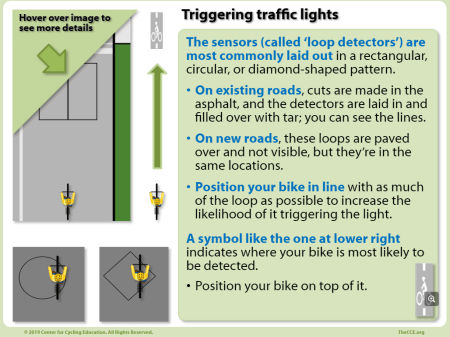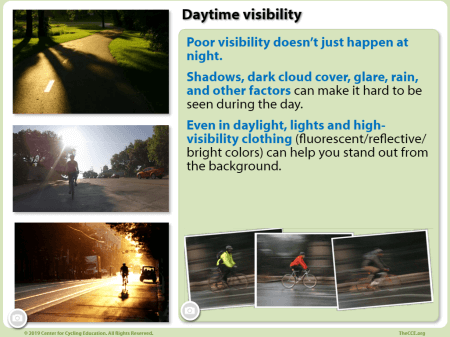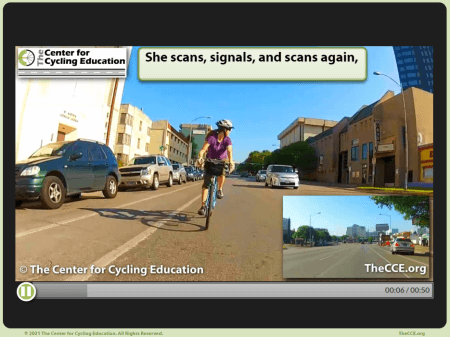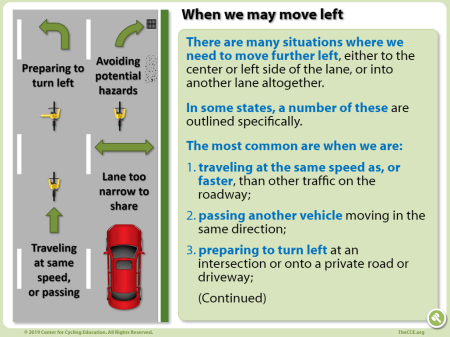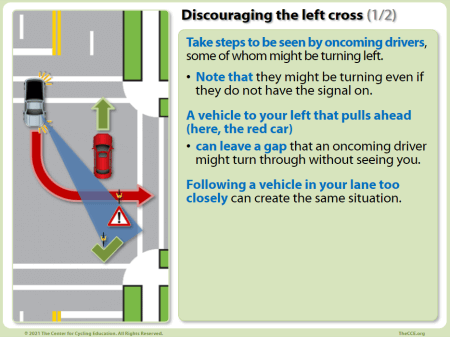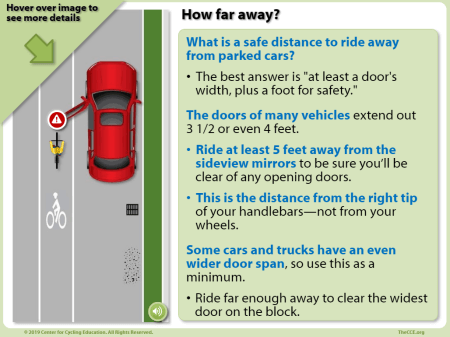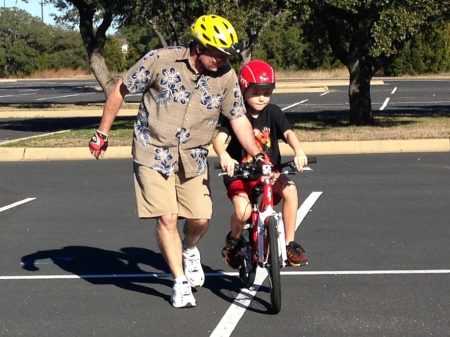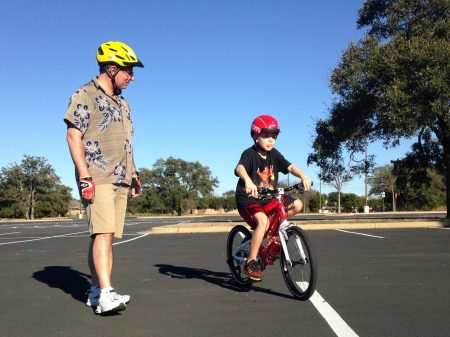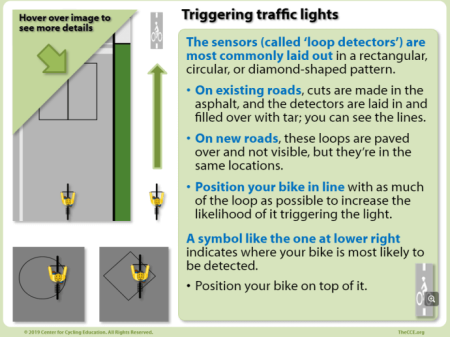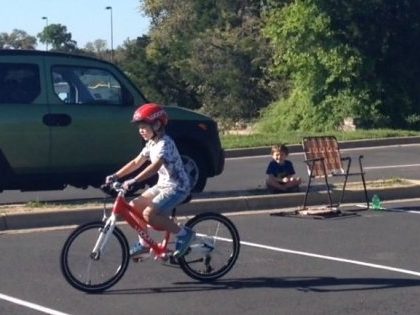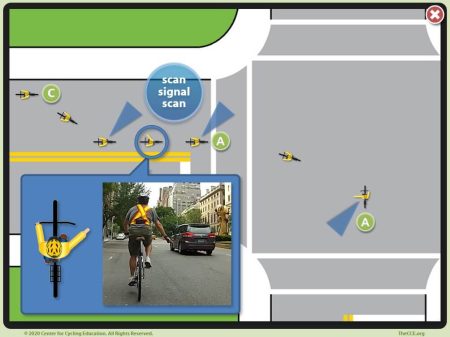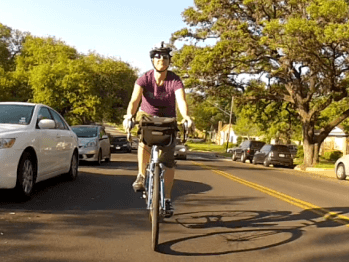State cycling laws for California
There are no federal laws outlining the rules of the road. Instead, each state has its own set of traffic laws. In many cases, these are based at least in part on the Uniform Vehicle Code.
The California Vehicle Code governs bicycling in the state.
In addition to this, many counties, cities/towns, campuses, & military bases may have their own traffic regulations, usually known as ordinances or codes.
These local regulations may not take away any rights listed in the state traffic laws, unless this option is expressly permitted by the state. They also may not permit a person riding a bike to do anything prohibited by state law.
See below for the state laws that apply to riding your bike in California.
USA » CA – California » California Vehicle Code
Pedal Bicycles
Table of Contents
Links directly below are to sections on this page.
CALIFORNIA VEHICLE CODE
DIVISION 1. WORDS AND PHRASES DEFINED [100 – 681]
DIVISION 11. RULES OF THE ROAD [21000 – 23336]
CHAPTER 1. Obedience to and Effect of Traffic Laws [21000 – 21296]
» ARTICLE 4. Operation of Bicycles [21200 – 21213]
- (Note: These headings are not part of the California Vehicle Code, but are added here for clarification.)
- Rights and Duties of Cyclists [21200.]
- Alcohol and Drugs [21200.5.]
- Required and Prohibited Equipment [21201. / 21201.3. / 21201.5.]
- Position on the Roadway [21202.]
- General Operation of the Bicycle [21203. / 21204. / 21205. / 21206. / 21207.]
- Driving or Riding in Bicycle Lanes [21208. / 21209.]
- Parking the Bicycle: Sidewalks and Bikeways [21210. / 21211.]
- Helmet Use [21212. / 40303.5 / See also ‘Electric Bicycles’]
CHAPTER 2. Traffic Signs, Signals, and Markings [21350 – 21468]
» ARTICLE 3. Offenses Relating to Traffic Devices [21450 – 21468]
- New Signals Must Detect Bicycles and Motorcycles [21450. / 21450.5.]
- Obedience to Traffic Control Devices [21461. / 21461.5 / 21462.]
CHAPTER 3. Driving, Overtaking, and Passing [21650 – 21760]
» ARTICLE 1. Driving on Right Side [21650 – 21664]
» ARTICLE 3. Overtaking and Passing [21750 – 21761]
CHAPTER 4. Right-of-Way [21800 – 21809]
CHAPTER 5. Pedestrians’ Rights and Duties [21949 – 21971]
CHAPTER 6. Turning and Stopping and Turning Signals [22100 – 22113]
DIVISION 12. EQUIPMENT OF VEHICLES [24000 – 28150]
CHAPTER 5. Other Equipment [27000 – 28150]
» ARTICLE 3.5. Headsets and Earplugs [27400- 27400.]
DIVISION 16.7. REGISTRATION AND LICENSING OF BICYCLES [39000 – 39011]
» Electric Bicycles [21207.5. / 21213. / 24016.]
Click on the Electric Bicycles tab (above, on a computer / below, on a mobile device).
CALIFORNIA VEHICLE CODE – VEH 
DIVISION 11. RULES OF THE ROAD [21000 – 23336] 
CHAPTER 1. Obedience to and Effect of Traffic Laws [21000 – 21296] 
ARTICLE 4. Operation of Bicycles [21200 – 21213] 
(Rights and Duties of Cyclists)
21200. ![]()
(a)
(1) A person riding a bicycle or operating a pedicab upon a highway has all the rights and is subject to all the provisions applicable to the driver of a vehicle by this division, including, but not limited to, provisions concerning driving under the influence of alcoholic beverages or drugs, and by Division 10 ![]() (commencing with Section 20000) [Accidents and Accident Reports] , Section 27400
(commencing with Section 20000) [Accidents and Accident Reports] , Section 27400 ![]() [Headsets and Earplugs], Division 16.7
[Headsets and Earplugs], Division 16.7 ![]() (commencing with Section 39000) [Registration and Licensing of Bicycles], Division 17
(commencing with Section 39000) [Registration and Licensing of Bicycles], Division 17 ![]() (commencing with Section 40000.1) [Offenses and Prosecution], and Division 18
(commencing with Section 40000.1) [Offenses and Prosecution], and Division 18 ![]() (commencing with Section 42000) [Penalties and Disposition of Fees, Fines, and Forfeitures], except those provisions which by their very nature can have no application.
(commencing with Section 42000) [Penalties and Disposition of Fees, Fines, and Forfeitures], except those provisions which by their very nature can have no application.
(2) A person operating a bicycle on a Class I bikeway, as defined in subdivision (a) of Section 890.4 ![]() of the Streets and Highways Code, has all the rights and is subject to all the provisions applicable to the driver of a vehicle pursuant to Section 20001
of the Streets and Highways Code, has all the rights and is subject to all the provisions applicable to the driver of a vehicle pursuant to Section 20001 ![]() [Accidents and Accident Reports], except those provisions which by their very nature can have no application.
[Accidents and Accident Reports], except those provisions which by their very nature can have no application.
(b)
(1) A peace officer, as defined in Chapter 4.5 ![]() (commencing with Section 830) of Title 3 of Part 2 of the Penal Code, operating a bicycle during the course of his or her duties is exempt from the requirements of subdivision (a), except as those requirements relate to driving under the influence of alcoholic beverages or drugs, if the bicycle is being operated under any of the following circumstances:
(commencing with Section 830) of Title 3 of Part 2 of the Penal Code, operating a bicycle during the course of his or her duties is exempt from the requirements of subdivision (a), except as those requirements relate to driving under the influence of alcoholic beverages or drugs, if the bicycle is being operated under any of the following circumstances:
(A) In response to an emergency call.
(B) While engaged in rescue operations.
(C) In the immediate pursuit of an actual or suspected violator of the law.
(2) This subdivision does not relieve a peace officer from the duty to operate a bicycle with due regard for the safety of all persons using the highway.
(Alcohol and Drugs)
21200.5. ![]()
Notwithstanding Section 21200, it is unlawful for any person to ride a bicycle upon a highway while under the influence of an alcoholic beverage or any drug, or under the combined influence of an alcoholic beverage and any drug. Any person arrested for a violation of this section may request to have a chemical test made of the person’s blood, breath, or urine for the purpose of determining the alcoholic or drug content of that person’s blood pursuant to Section 23612 ![]() , and, if so requested, the arresting officer shall have the test performed. A conviction of a violation of this section shall be punished by a fine of not more than two hundred fifty dollars ($250). Violations of this section are subject to Section 13202.5
, and, if so requested, the arresting officer shall have the test performed. A conviction of a violation of this section shall be punished by a fine of not more than two hundred fifty dollars ($250). Violations of this section are subject to Section 13202.5 ![]() .
.
(Required and Prohibited Equipment)
21201. ![]()
(a) No person shall operate a bicycle on a roadway unless it is equipped with a brake that will enable the operator to make one braked wheel skid on dry, level, clean pavement.
(b) No person shall operate on the highway a bicycle equipped with handlebars so raised that the operator must elevate his or her hands above the level of his or her shoulders in order to grasp the normal steering grip area.
(c) No person shall operate upon a highway a bicycle that is of a size that prevents the operator from safely stopping the bicycle, supporting it in an upright position with at least one foot on the ground, and restarting it in a safe manner.
(d) A bicycle operated during darkness upon a highway, a sidewalk where bicycle operation is not prohibited by the local jurisdiction, or a bikeway, as defined in Section 890.4 ![]() of the Streets and Highways Code, shall be equipped with all of the following:
of the Streets and Highways Code, shall be equipped with all of the following:
(1) A lamp emitting a white light that, while the bicycle is in motion, illuminates the highway, sidewalk, or bikeway in front of the bicyclist and is visible from a distance of 300 feet in front and from the sides of the bicycle.
(2) A red reflector or a solid or flashing red light with a built-in reflector on the rear that shall be visible from a distance of 500 feet to the rear when directly in front of lawful upper beams of headlamps on a motor vehicle.
(3) A white or yellow reflector on each pedal, shoe, or ankle visible from the front and rear of the bicycle from a distance of 200 feet.
(4) A white or yellow reflector on each side forward of the center of the bicycle, and a white or red reflector on each side to the rear of the center of the bicycle, except that bicycles that are equipped with reflectorized tires on the front and the rear need not be equipped with these side reflectors. The reflectors and reflectorized tires shall be of a type meeting requirements established by the department.
(e) A lamp or lamp combination, emitting a white light, attached to the operator and visible from a distance of 300 feet in front and from the sides of the bicycle, may be used in lieu of the lamp required by paragraph (1) of subdivision (d).
21201.3. ![]()
(a) A bicycle or motorized bicycle used by a peace officer, as defined ![]() in Section 830.1 of, subdivision (a), (b), (c), (d), (e), (f), (g), or (i) of Section 830.2 of, subdivision (b) or (d) of Section 830.31 of, subdivision (a) or (b) of Section 830.32 of, Section 830.33 of, subdivision (a) of Section 830.36 of, subdivision (a) of Section 830.4 of, or Section 830.6 of, the Penal Code, in the performance of the peace officer’s duties, may display a steady or flashing blue warning light that is visible from the front, sides, or rear of the bicycle or motorized bicycle.
in Section 830.1 of, subdivision (a), (b), (c), (d), (e), (f), (g), or (i) of Section 830.2 of, subdivision (b) or (d) of Section 830.31 of, subdivision (a) or (b) of Section 830.32 of, Section 830.33 of, subdivision (a) of Section 830.36 of, subdivision (a) of Section 830.4 of, or Section 830.6 of, the Penal Code, in the performance of the peace officer’s duties, may display a steady or flashing blue warning light that is visible from the front, sides, or rear of the bicycle or motorized bicycle.
(b) No person shall display a steady or flashing blue warning light on a bicycle or motorized bicycle except as authorized under subdivision (a).
21201.5. ![]()
(a) No person shall sell, or offer for sale, a reflex reflector or reflectorized tire of a type required on a bicycle unless it meets requirements established by the department. If there exists a federal Consumer Product Safety Commission regulation applicable to bicycle reflectors, the provisions of that regulation shall prevail over provisions of this code or requirements established by the department pursuant to this code relative to bicycle reflectors.
(b) No person shall sell, or offer for sale, a new bicycle that is not equipped with a red reflector on the rear, a white or yellow reflector on each pedal visible from the front and rear of the bicycle, a white or yellow reflector on each side forward of the center of the bicycle, and a white or red reflector on each side to the rear of the center of the bicycle, except that bicycles which are equipped with reflectorized tires on the front and rear need not be equipped with these side reflectors.
(c) Area reflectorizing material meeting the requirements of Section 25500 ![]() may be used on a bicycle.
may be used on a bicycle.
(Position on the Roadway)
21202. ![]()
(a) Any person operating a bicycle upon a roadway at a speed less than the normal speed of traffic moving in the same direction at that time shall ride as close as practicable to the right-hand curb or edge of the roadway except under any of the following situations:
(1) When overtaking and passing another bicycle or vehicle proceeding in the same direction.
(2) When preparing for a left turn at an intersection or into a
private road or driveway.
(3) When reasonably necessary to avoid conditions (including, but not limited to, fixed or moving objects, vehicles, bicycles, pedestrians, animals, surface hazards, or substandard width lanes) that make it unsafe to continue along the right-hand curb or edge, subject to the provisions of Section 21656 ![]() . For purposes of this section, a “substandard width lane” is a lane that is too narrow for a bicycle and a vehicle to travel safely side by side within the lane.
. For purposes of this section, a “substandard width lane” is a lane that is too narrow for a bicycle and a vehicle to travel safely side by side within the lane.
(4) When approaching a place where a right turn is authorized.
(b) Any person operating a bicycle upon a roadway of a highway, which highway carries traffic in one direction only and has two or more marked traffic lanes, may ride as near the left-hand curb or edge of that roadway as practicable.
(General Operation of the Bicycle)
21203. ![]()
No person riding upon any motorcycle, motorized bicycle, bicycle, coaster, roller skates, sled, or toy vehicle shall attach the same or himself to any streetcar or vehicle on the roadway.
21204. ![]()
(a) A person operating a bicycle upon a highway shall not ride other than upon or astride a permanent and regular seat attached thereto, unless the bicycle was designed by the manufacturer to be ridden without a seat.
(b) An operator shall not allow a person riding as a passenger, and a person shall not ride as a passenger, on a bicycle upon a highway other than upon or astride a separate seat attached thereto. If the passenger is four years of age or younger, or weighs 40 pounds or less, the seat shall have adequate provision for retaining the passenger in place and for protecting the passenger from the moving parts of the bicycle.
21205. ![]()
No person operating a bicycle shall carry any package, bundle or article which prevents the operator from keeping at least one hand upon the handlebars.
21206. ![]()
This chapter does not prevent local authorities, by ordinance, from regulating the registration of bicycles and the parking and operation of bicycles on pedestrian or bicycle facilities, provided such regulation is not in conflict with the provisions of this code.
21207. ![]()
(a) This chapter does not prohibit local authorities from establishing, by ordinance or resolution, bicycle lanes separated from any vehicular lanes upon highways, other than state highways as defined in Section 24 ![]() of the Streets and Highways Code and county highways established pursuant to Article 5 (commencing with Section 1720)
of the Streets and Highways Code and county highways established pursuant to Article 5 (commencing with Section 1720) ![]() of Chapter 9 of Division 2 of the Streets and Highways Code.
of Chapter 9 of Division 2 of the Streets and Highways Code.
(b) Bicycle lanes established pursuant to this section shall be constructed in compliance with Section 891 ![]() of the Streets and Highways Code.
of the Streets and Highways Code.
(Driving or Riding in Bicycle Lanes)
21208. ![]()
(a) Whenever a bicycle lane has been established on a roadway pursuant to Section 21207, any person operating a bicycle upon the roadway at a speed less than the normal speed of traffic moving in the same direction at that time shall ride within the bicycle lane, except that the person may move out of the lane under any of the following situations:
(1) When overtaking and passing another bicycle, vehicle, or pedestrian within the lane or about to enter the lane if the overtaking and passing cannot be done safely within the lane.
(2) When preparing for a left turn at an intersection or into a private road or driveway.
(3) When reasonably necessary to leave the bicycle lane to avoid debris or other hazardous conditions.
(4) When approaching a place where a right turn is authorized.
(b) No person operating a bicycle shall leave a bicycle lane until the movement can be made with reasonable safety and then only after giving an appropriate signal in the manner provided in Chapter 6 (commencing with Section 22100) ![]() in the event that any vehicle may be affected by the movement.
in the event that any vehicle may be affected by the movement.
21209. ![]()
(a) No person shall drive a motor vehicle in a bicycle lane established on a roadway pursuant to Section 21207 except as follows:
(1) To park where parking is permitted.
(2) To enter or leave the roadway.
(3) To prepare for a turn within a distance of 200 feet from the intersection.
(b) This section does not prohibit the use of a motorized bicycle in a bicycle lane, pursuant to Section 21207.5, at a speed no greater than is reasonable or prudent, having due regard for visibility, traffic conditions, and the condition of the roadway surface of the bicycle lane, and in a manner which does not endanger the safety of bicyclists.
(Parking the Bicycle: Sidewalks and Bikeways)
21210. ![]()
No person shall leave a bicycle lying on its side on any sidewalk, or shall park a bicycle on a sidewalk in any other position, so that there is not an adequate path for pedestrian traffic. Local authorities may, by ordinance or resolution, prohibit bicycle parking in designated areas of the public highway, provided that appropriate signs are erected.
21211. ![]()
(a) No person may stop, stand, sit, or loiter upon any class I bikeway, as defined in subdivision (a) of Section 890.4 ![]() of the Streets and Highways Code, or any other public or private bicycle path or trail, if the stopping, standing, sitting, or loitering impedes or blocks the normal and reasonable movement of any bicyclist.
of the Streets and Highways Code, or any other public or private bicycle path or trail, if the stopping, standing, sitting, or loitering impedes or blocks the normal and reasonable movement of any bicyclist.
(b) No person may place or park any bicycle, vehicle, or any other object upon any bikeway or bicycle path or trail, as specified in subdivision (a), which impedes or blocks the normal and reasonable movement of any bicyclist unless the placement or parking is necessary for safe operation or is otherwise in compliance with the law.
(c) This section does not apply to drivers or owners of utility or public utility vehicles, as provided in Section 22512.
(d) This section does not apply to owners or drivers of vehicles who make brief stops while engaged in the delivery of newspapers to customers along the person’s route.
(e) This section does not apply to the driver or owner of a rubbish or garbage truck while actually engaged in the collection of rubbish or garbage within a business or residence district if the front turn signal lamps at each side of the vehicle are being flashed simultaneously and the rear turn signal lamps at each side of the vehicle are being flashed simultaneously.
(f) This section does not apply to the driver or owner of a tow vehicle while actually engaged in the towing of a vehicle if the front turn signal lamps at each side of the vehicle are being flashed simultaneously and the rear turn signal lamps at each side of the vehicle are being flashed simultaneously.
(Helmet Use)
21212. ![]()
(a) A person under 18 years of age shall not operate a bicycle, a nonmotorized scooter, or a skateboard, nor wear in-line or roller skates, nor ride upon a bicycle, a nonmotorized scooter, or a skateboard as a passenger, upon a street, bikeway, as defined in Section 890.4 ![]() of the Streets and Highways Code, or any other public bicycle path or trail unless that person is wearing a properly fitted and fastened bicycle helmet that meets the standards of either the American Society for Testing and Materials (ASTM) or the United States Consumer Product Safety Commission (CPSC), or standards subsequently established by those entities. This requirement also applies to a person who rides upon a bicycle while in a restraining seat that is attached to the bicycle or in a trailer towed by the bicycle.
of the Streets and Highways Code, or any other public bicycle path or trail unless that person is wearing a properly fitted and fastened bicycle helmet that meets the standards of either the American Society for Testing and Materials (ASTM) or the United States Consumer Product Safety Commission (CPSC), or standards subsequently established by those entities. This requirement also applies to a person who rides upon a bicycle while in a restraining seat that is attached to the bicycle or in a trailer towed by the bicycle.
(b) A helmet sold or offered for sale for use by operators and passengers of bicycles, nonmotorized scooters, skateboards, or in-line or roller skates shall be conspicuously labeled in accordance with the standard described in subdivision (a), which shall constitute the manufacturer’s certification that the helmet conforms to the applicable safety standards.
(c) A person shall not sell, or offer for sale, for use by an operator or passenger of a bicycle, nonmotorized scooter, skateboard, or in-line or roller skates any safety helmet that is not of a type meeting requirements established by this section.
(d) A charge under this section shall be dismissed when the person charged alleges in court, under oath, that the charge against the person is the first charge against that person under this section, unless it is otherwise established in court that the charge is not the first charge against the person.
(e)
(1) Except as provided in subdivision (d), a violation of this section is an infraction punishable by a fine of not more than twenty-five dollars ($25).
(2) The parent or legal guardian having control or custody of an unemancipated minor whose conduct violates this section shall be jointly and severally liable with the minor for the amount of the fine imposed pursuant to this subdivision.
(f) A record of the action shall not be transmitted to the court and a fee shall not be imposed pursuant to Section 40611 ![]() upon a citation for not wearing a properly fitted and fastened bicycle helmet pursuant to subdivision (a) if the parent or legal guardian of the person described in subdivision (a) delivers proof to the issuing agency within 120 days after the citation was issued that the person has a helmet meeting the requirements specified in subdivision (a) and the person has completed a local bicycle safety course or a related safety course, if one is available, as prescribed by authorities in the local jurisdiction.
upon a citation for not wearing a properly fitted and fastened bicycle helmet pursuant to subdivision (a) if the parent or legal guardian of the person described in subdivision (a) delivers proof to the issuing agency within 120 days after the citation was issued that the person has a helmet meeting the requirements specified in subdivision (a) and the person has completed a local bicycle safety course or a related safety course, if one is available, as prescribed by authorities in the local jurisdiction.
SEC. 2. Section 40303.5 of the Vehicle Code is amended to read: ![]()
40303.5. ![]()
An arresting officer shall permit a person arrested for any of the following offenses to execute a notice containing a promise to correct the violation in accordance with the provisions of Section 40610 ![]() unless the arresting officer finds that any of the disqualifying conditions specified in subdivision (b) of Section 40610 exist:
unless the arresting officer finds that any of the disqualifying conditions specified in subdivision (b) of Section 40610 exist:
(c) Section 21201, relating to bicycle equipment.
(d) Subdivision (a) of Section 21212.
(e) An infraction involving equipment set forth in Division 12 (commencing with Section 24000), Division 13 (commencing with Section 29000), Division 14.8 (commencing with Section 34500), Division 16 (commencing with Section 36000), Division 16.5 (commencing with Section 38000), and Division 16.7 (commencing with Section 39000).
CHAPTER 2. Traffic Signs, Signals, and Markings [21350 – 21468] 
ARTICLE 3. Offenses Relating to Traffic Devices [21450 – 21468] 
(New Signals Must Detect Bicycles and Motorcycles)
21450. ![]()
Whenever traffic is controlled by official traffic control signals showing different colored lights, color-lighted arrows, or color-lighted bicycle symbols, successively, one at a time, or in combination, only the colors green, yellow, and red shall be used, except for pedestrian control signals, and those lights shall indicate and apply to drivers of vehicles, operators of bicycles, and pedestrians as provided in this chapter.
21450.5. ![]()
(a) A traffic-actuated signal is an official traffic control signal, as specified in Section 445, that displays one or more of its indications in response to the presence of traffic detected by mechanical, visual, electrical, or other means.
(b) Upon the first placement of a traffic-actuated signal or replacement of the loop detector of a traffic-actuated signal, the traffic-actuated signal shall, to the extent feasible and in conformance with professional traffic engineering practice, be installed and maintained so as to detect lawful bicycle or motorcycle traffic on the roadway.
(c) Cities, counties, and cities and counties shall not be required to comply with the provisions contained in subdivision (b) until the Department of Transportation, in consultation with these entities, has established uniform standards, specifications, and guidelines for the detection of bicycles and motorcycles by traffic-actuated signals and related signal timing.
(Obedience to Traffic Control Devices)
21461. ![]()
(a) It is unlawful for a driver of a vehicle to fail to obey a sign or signal defined as regulatory in the federal Manual on Uniform Traffic Control Devices, or a Department of Transportation approved supplement to that manual of a regulatory nature erected or maintained to enhance traffic safety and operations or to indicate and carry out the provisions of this code or a local traffic ordinance or resolution adopted pursuant to a local traffic ordinance, or to fail to obey a device erected or maintained by lawful authority of a public body or official.
(b) Subdivision (a) does not apply to acts constituting violations under Chapter 9 (commencing with Section 22500) [Stopping, Standing, and Parking] of this division or to acts constituting violations of a local traffic ordinance adopted pursuant to Chapter 9 (commencing with Section 22500).
21461.5. ![]()
It shall be unlawful for any pedestrian to fail to obey any sign or signal erected or maintained to indicate or carry out the provisions of this code or any local traffic ordinance or resolution adopted pursuant to a local traffic ordinance, or to fail to obey any device erected or maintained pursuant to Section 21352 ![]() .
.
21462. ![]()
The driver of any vehicle, the person in charge of any animal, any pedestrian, and the motorman of any streetcar shall obey the instructions of any official traffic signal applicable to him and placed as provided by law, unless otherwise directed by a police or traffic officer or when it is necessary for the purpose of avoiding a collision or in case of other emergency, subject to the exemptions granted by Section 21055 ![]() [re: driver of an authorized emergency vehicle].
[re: driver of an authorized emergency vehicle].
CHAPTER 3. Driving, Overtaking, and Passing [21650 – 21760] 
ARTICLE 1. Driving on Right Side [21650 – 21664] 
21650. 
Upon all highways, a vehicle shall be driven upon the right half of the roadway, except as follows:
(a) When overtaking and passing another vehicle proceeding in the same direction under the rules governing that movement.
(b) When placing a vehicle in a lawful position for, and when the vehicle is lawfully making, a left turn.
(c) When the right half of a roadway is closed to traffic under construction or repair.
(d) Upon a roadway restricted to one-way traffic.
(e) When the roadway is not of sufficient width.
(f) When the vehicle is necessarily traveling so slowly as to impede the normal movement of traffic, that portion of the highway adjacent to the right edge of the roadway may be utilized temporarily when in a condition permitting safe operation.
(g) This section does not prohibit the operation of bicycles on any shoulder of a highway, on any sidewalk, on any bicycle path within a highway, or along any crosswalk or bicycle path crossing, where the operation is not otherwise prohibited by this code or local ordinance.
(h) This section does not prohibit the operation of a transit bus on the shoulder of a state highway in conjunction with the implementation of a program authorized pursuant to Section 148.1 of the Streets and Highways Code on state highways within the areas served by the transit services of the Monterey-Salinas Transit District or the Santa Cruz Metropolitan Transit District.
21650.1. 
A bicycle operated on a roadway, or the shoulder of a highway, shall be operated in the same direction as vehicles are required to be driven upon the roadway.
21656. 
On a two-lane highway where passing is unsafe because of traffic in the opposite direction or other conditions, any vehicle proceeding upon the highway at a speed less than the normal speed of traffic moving in the same direction at that time, behind which five or more vehicles are formed in line, shall turn off the roadway at the nearest place designated as a turnout by signs erected by the authority having jurisdiction over the highway, or wherever sufficient area for a safe turnout exists, in order to permit the vehicles following it to proceed.
(Passing on the Right)
21754. ![]() The driver of a vehicle may overtake and pass to the right of another vehicle only under the following conditions:
The driver of a vehicle may overtake and pass to the right of another vehicle only under the following conditions:
(a) When the vehicle overtaken is making or about to make a left turn.
(b) Upon a highway within a business or residence district with unobstructed pavement of sufficient width for two or more lines of moving vehicles in the direction of travel.
(c) Upon any highway outside of a business or residence district with unobstructed pavement of sufficient width and clearly marked for two or more lines of moving traffic in the direction of travel.
(d) Upon a one-way street.
(e) Upon a highway divided into two roadways where traffic is restricted to one direction upon each of such roadways.
The provisions of this section shall not relieve the driver of a slow moving vehicle from the duty to drive as closely as practicable to the right hand edge of the roadway.
21755. ![]()
(a) The driver of a vehicle may overtake and pass another vehicle upon the right only under conditions permitting that movement in safety. In no event shall that movement be made by driving off the paved or main-traveled portion of the roadway.
(b) This section does not prohibit the use of a bicycle in a bicycle lane or on a shoulder.
CHAPTER 4. Right-of-Way [21800 – 21809] 
(Inoperative Traffic Control Signal)
21800. ![]()
(d) (1) The driver of any vehicle approaching an intersection which has official traffic control signals that are inoperative shall stop at the intersection, and may proceed with caution when it is safe to do so.
CHAPTER 5. Pedestrians’ Rights and Duties [21949 – 21971] 
(Prohibiting or Restricting Use of Freeways, Expressways)
21960. ![]()
(a) The Department of Transportation and local authorities, by order, ordinance, or resolution, with respect to freeways, expressways, or designated portions thereof under their respective jurisdictions, to which vehicle access is completely or partially controlled, may prohibit or restrict the use of the freeways, expressways, or any portion thereof by pedestrians, bicycles or other nonmotorized traffic or by any person operating a motor-driven cycle, motorized bicycle, motorized scooter, or electrically motorized board. A prohibition or restriction pertaining to bicycles, motor-driven cycles, motorized scooters, or electrically motorized boards shall be deemed to include motorized bicycles. A person shall not operate a motorized bicycle wherever that prohibition or restriction is in force. Notwithstanding any order, ordinance, or resolution to the contrary, the driver or passengers of a disabled vehicle stopped on a freeway or expressway may walk to the nearest exit, in either direction, on that side of the freeway or expressway upon which the vehicle is disabled, from which telephone or motor vehicle repair services are available.
(b) The prohibitory regulation authorized by subdivision (a) shall be effective when appropriate signs giving notice thereof are erected upon any freeway or expressway and the approaches thereto. If any portion of a county freeway or expressway is contained within the limits of a city within the county, the county may erect signs on that portion as required under this subdivision if the ordinance has been approved by the city pursuant to subdivision (b) of Section 1730 of the Streets and Highways Code.
(c) No ordinance or resolution of local authorities shall apply to any state highway until the proposed ordinance or resolution has been presented to, and approved in writing by, the Department of Transportation.
(d) An ordinance or resolution adopted under this section on or after January 1, 2005, to prohibit pedestrian access to a county freeway or expressway shall not be effective unless it is supported by a finding by the local authority that the freeway or expressway does not have pedestrian facilities and pedestrian use would pose a safety risk to the pedestrian.
CHAPTER 6. Turning and Stopping and Turning Signals [22100 – 22113] 
22107. ![]() No person shall turn a vehicle from a direct course or move right or left upon a roadway until such movement can be made with reasonable safety and then only after the giving of an appropriate signal in the manner provided in this chapter in the event any other vehicle may be affected by the movement.
No person shall turn a vehicle from a direct course or move right or left upon a roadway until such movement can be made with reasonable safety and then only after the giving of an appropriate signal in the manner provided in this chapter in the event any other vehicle may be affected by the movement.
22108. ![]() Any signal of intention to turn right or left shall be given continuously during the last 100 feet traveled by the vehicle before turning.
Any signal of intention to turn right or left shall be given continuously during the last 100 feet traveled by the vehicle before turning.
22109. ![]() No person shall stop or suddenly decrease the speed of a vehicle on a highway without first giving an appropriate signal in the manner provided in this chapter to the driver of any vehicle immediately to the rear when there is opportunity to give the signal.
No person shall stop or suddenly decrease the speed of a vehicle on a highway without first giving an appropriate signal in the manner provided in this chapter to the driver of any vehicle immediately to the rear when there is opportunity to give the signal.
22111. ![]() All required signals given by hand and arm shall be given from the left side of a vehicle in the following manner:
All required signals given by hand and arm shall be given from the left side of a vehicle in the following manner:
(a) Left turn—hand and arm extended horizontally beyond the side of the vehicle.
(b) Right turn—hand and arm extended upward beyond the side of the vehicle, except that a bicyclist may extend the right hand and arm horizontally to the right side of the bicycle.
(c) Stop or sudden decrease of speed signal—hand and arm extended downward beyond the side of the vehicle.
DIVISION 12. EQUIPMENT OF VEHICLES [24000 – 28150] 
CHAPTER 5. Other Equipment [27000 – 28150] 
ARTICLE 3.5. Headsets and Earplugs [27400- 27400.] 
27400. ![]()
A person operating a motor vehicle or bicycle may not wear a headset covering, earplugs in, or earphones covering, resting on, or inserted in, both ears. This prohibition does not apply to any of the following:
(a) A person operating authorized emergency vehicles, as defined in Section 165.
(b) A person engaged in the operation of either special construction equipment or equipment for use in the maintenance of any highway.
(c) A person engaged in the operation of refuse collection equipment who is wearing a safety headset or safety earplugs.
(d) A person wearing personal hearing protectors in the form of earplugs or molds that are specifically designed to attenuate injurious noise levels. The plugs or molds shall be designed in a manner so as to not inhibit the wearer’s ability to hear a siren or horn from an emergency vehicle or a horn from another motor vehicle.
(e) A person using a prosthetic device that aids the hard of hearing.
DIVISION 16.7. REGISTRATION AND LICENSING OF BICYCLES [39000 – 39011] 
39000. ![]()
“Bicycle”, for the purposes of this division, means any device upon which a person may ride, which is propelled by human power through a system of belts, chains, or gears having either two or three wheels (one of which is at least 20 inches in diameter) or having a frame size of at least 14 inches, or having four or more wheels.
39001. ![]()
(a) The department shall procure and distribute bicycle license indicia and registration forms to all counties and cities which have adopted a bicycle licensing ordinance or resolution. Those counties and cities shall issue the indicia and registration form to the owner of any new bicycle, and may, upon request of the owner, issue an indicia and registration form to the owner of any bicycle which complies with Section 39007.
The department shall charge and collect a fee, not to exceed the cost of procuring and distributing the license indicia and registration form, for each bicycle license indicia and registration form issued. All fees collected pursuant to this section shall be deposited in the Motor Vehicle Account in the State Transportation Fund. Those fees are hereby continuously appropriated from the account for use by the department to defray costs to procure and distribute the bicycle license indicia and registration forms.
(b) The director shall design the bicycle license indicia and registration form described in subdivision (a), and shall establish procedures for the distribution of the indicia and registration form to counties and cities. The indicia shall be adhesive, durable, flexible, and of a size to permit it to be affixed to the front of the seat tube of the bicycle frame. Each indicia shall bear a unique license number and shall be permanently assigned to a bicycle. Each registration form shall comply with Section 39005.
(c) Bicycle licenses shall be renewed uniformly throughout the state on January 1 of the third year following the year of registration. Renewal of a bicycle license shall be indicated by a supplementary adhesive device affixed parallel to, and above or below, the indicia, with the expiration date showing.
39002. ![]()
(a) A city or county, which adopts a bicycle licensing ordinance or resolution, may provide in the ordinance or resolution that no resident shall operate any bicycle, as specified in the ordinance, on any street, road, highway, or other public property within the jurisdiction of the city or county, as the case may be, unless the bicycle is licensed in accordance with this division.
(b) It is unlawful for any person to tamper with, destroy, mutilate, or alter any license indicia or registration form, or to remove, alter, or mutilate the serial number, or the identifying marks of a licensing agency’s identifying symbol, on any bicycle frame licensed under this division.
39003. ![]()
If a city or county has or adopts a bicycle licensing ordinance or resolution, indicia and a copy of the registration form obtained from the department shall be issued to the owner by the city or county or other licensing agency designated by it.
39004. ![]()
Each licensing agency, by ordinance or resolution, may adopt rules and regulations for the collection of license fees. Revenues from license fees shall be retained by the licensing city or county and shall be used for the support of such bicycle ordinance or resolution, and may be used to reimburse retailers for services rendered. In addition, fees collected shall be used to improve bicycle safety programs and establish bicycle facilities, including bicycle paths and lanes, within the limits of the jurisdiction.
The fees required to be paid pursuant to this division are as follows:
(a) For each new bicycle license and registration certificate, the sum shall not exceed four dollars ($4) per year or any portion thereof.
(b) For each transfer of registration certificate, the sum shall not exceed two dollars ($2).
(c) For each replacement of a bicycle license or registration certificate, the sum shall not exceed two dollars ($2).
(d) For each bicycle license renewal, the sum shall not exceed two dollars ($2) per year.
39005. ![]()
Cities and counties having a bicycle licensing ordinance or resolution shall maintain records of each bicycle registered. Such records shall include, but not be limited to, the license number, the serial number of the bicycle, the make and type, of the bicycle, and the name and address of the licensee.
Records shall be maintained by the licensing agency during the period of validity of the license or until notification that the bicycle is no longer to be operated.
39006. ![]()
(a) Each bicycle retailer and each bicycle dealer shall supply to each purchaser a preregistration form provided by the licensing agency and shall include, on the sales check or receipt given to the purchaser, a record of the following information: name of retailer, address of retailer, year and make of the bicycle, serial number of the bicycle if delivered to the purchaser in an assembled state, general description of the bicycle, name of purchaser, and address of purchaser. A copy of the preregistration form shall be filled out and forwarded by the purchaser to the appropriate licensing agency within 10 days from the date of sale.
(b) For the purposes of this division, a bicycle dealer is any person who sells, gives away, buys, or takes in trade for the purpose of resale, more than five bicycles in any one calendar year, whether or not such bicycles are owned by such person. “Bicycle dealer” also includes agents or employees of such person.
39007. ![]()
After December 31, 1976, no bicycle retailer shall sell any new bicycle in this state unless such bicycle has legibly and permanently stamped or cast on its frame a serial number, no less than one-eighth inch in size, and unique to the particular bicycle of each manufacturer. The serial number only shall be stamped or cast in the head of the frame, either side of the seat tube, the toeplate, or the bottom sprocket (crank) housing.
39008. ![]()
(a) Whenever any person sells or otherwise disposes of a bicycle, he shall endorse upon the registration certificate previously issued for such bicycle a written transfer of same, setting forth the name, address, telephone number of the transferee, date of transfer, and signature of the transferrer, and shall deliver the registration certificate, so endorsed, to the licensing agency within 10 days.
(b) Any person who purchases or otherwise acquires possession of a bicycle shall, within 10 days of taking possession, apply for the transfer of license to his own name. Cities and counties may establish rules and regulations to govern and enforce the provisions of this section.
39009. ![]()
(a) Whenever the owner of a bicycle licensed pursuant to an ordinance or resolution of a city or county changes his address, he shall within 10 days notify the appropriate licensing agency of the old and new address.
(b) In the event that any bicycle license indicia or registration form issued pursuant to the provisions of this division is lost, stolen, or mutilated, the licensee of such bicycle shall immediately notify the licensing agency, and, within 10 days after such notification, shall apply to the licensing agency for a duplicate license indicia or registration form. Thereupon, the licensing agency shall issue to such licensee a replacement indicia or registration form upon payment to the licensing agency of the appropriate fee.
39011. ![]()
No fine imposed for any violation of an ordinance or resolution, which is adopted pursuant to this division, shall exceed ten dollars ($10).
Electric Bicycles
In addition to the rules of the road outlined in the section for pedal bicycles,
the operator of an electric bicycle is subject to the following regulations:
21207.5. ![]()
(a) Notwithstanding Sections 21207 and 23127 of this code, or any other law, a motorized bicycle or class 3 electric bicycle shall not be operated on a bicycle path or trail, bikeway, bicycle lane established pursuant to Section 21207, equestrian trail, or hiking or recreational trail, unless it is within or adjacent to a roadway or unless the local authority or the governing body of a public agency having jurisdiction over the path or trail permits, by ordinance, that operation.
(b) The local authority or governing body of a public agency having jurisdiction over a bicycle path or trail, equestrian trail, or hiking or recreational trail, may prohibit, by ordinance, the operation of a class 1 or class 2 electric bicycle on that path or trail.
21213. ![]()
(a) A person under 16 years of age shall not operate a class 3 electric bicycle.
(b) A person shall not operate a class 3 electric bicycle, or ride upon a class 3 electric bicycle as a passenger, upon a street, bikeway, as defined in Section 890.4 ![]() of the Streets and Highways Code, or any other public bicycle path or trail, unless that person is wearing a properly fitted and fastened bicycle helmet that meets the standards of either the American Society for Testing and Materials (ASTM) or the United States Consumer Product Safety Commission (CPSC), or standards subsequently established by those entities. This helmet requirement also applies to a person who rides upon a class 3 electric bicycle while in a restraining seat that is attached to the bicycle or in a trailer towed by the bicycle.
of the Streets and Highways Code, or any other public bicycle path or trail, unless that person is wearing a properly fitted and fastened bicycle helmet that meets the standards of either the American Society for Testing and Materials (ASTM) or the United States Consumer Product Safety Commission (CPSC), or standards subsequently established by those entities. This helmet requirement also applies to a person who rides upon a class 3 electric bicycle while in a restraining seat that is attached to the bicycle or in a trailer towed by the bicycle.
24016. ![]()
(a) An electric bicycle described in subdivision (a) of Section 312.5 shall meet the following criteria:
(1) Comply with the equipment and manufacturing requirements for bicycles adopted by the United States Consumer Product Safety Commission (16 C.F.R. 1512.1, et seq.).
(2) Operate in a manner so that the electric motor is disengaged or ceases to function when the brakes are applied, or operate in a manner such that the motor is engaged through a switch or mechanism that, when released or activated, will cause the electric motor to disengage or cease to function.
(b) A person operating an electric bicycle is not subject to the provisions of this code relating to financial responsibility, driver’s licenses, registration, and license plate requirements, and an electric bicycle is not a motor vehicle.
(c) Every manufacturer of an electric bicycle shall certify that it complies with the equipment and manufacturing requirements for bicycles adopted by the United States Consumer Product Safety Commission (16 C.F.R. 1512.1, et seq.).
(d) A person shall not tamper with or modify an electric bicycle described in subdivision (a) of Section 312.5 so as to change the speed capability of the bicycle, unless he or she appropriately replaces the label indicating the classification required in subdivision (c) of Section 312.5.
(Amended by Stats. 2015, Ch. 568, Sec. 7. (AB 1096) Effective January 1, 2016.)
Definitions
DIVISION 1. WORDS AND PHRASES DEFINED [100 – 681] 
100. Unless the provision or context otherwise requires, these definitions shall govern the construction of this code.
109. “Alcoholic beverage” includes any liquid or solid material intended to be ingested by a person which contains ethanol, also known as ethyl alcohol, drinking alcohol, or alcohol, including, but not limited to, alcoholic beverages as defined in Section 23004 of the Business and Professions Code, intoxicating liquor, malt beverage, beer, wine, spirits, liqueur, whiskey, rum, vodka, cordials, gin, and brandy, and any mixture containing one or more alcoholic beverages. Alcoholic beverage includes a mixture of one or more alcoholic beverages whether found or ingested separately or as a mixture.
For purposes of the Driver License Compact, “intoxicating liquor” as used in Section 15023 has the same meaning as “alcoholic beverage” as used in this code.
110. “Alley” is any highway having a roadway not exceeding 25 feet in width which is primarily used for access to the rear or side entrances of abutting property; provided, that the City and County of San Francisco may designate by ordinance or resolution as an “alley” any highway having a roadway not exceeding 25 feet in width.
112. “Amber” has the same meaning as “yellow,” and is within the chromaticity coordinate boundaries for yellow specified in regulations adopted by the Department of the California Highway Patrol.
231. A bicycle is a device upon which any person may ride, propelled exclusively by human power through a belt, chain, or gears, and having one or more wheels. Persons riding bicycles are subject to the provisions of this code specified in Sections 21200 and 21200.5.
231.5. A “bicycle path” or “bike path” is a Class I bikeway, as defined in subdivision (a) of Section 890.4 of the Streets and Highways Code.
231.6.
(a) A “bicycle path crossing” is either of the following:
(1) That portion of a roadway included within the prolongation or connection of the boundary lines of a bike path at intersections where the intersecting roadways meet at approximately right angles.
(2) Any portion of a roadway distinctly indicated for bicycle crossing by lines or other markings on the surface.
(b) Notwithstanding subdivision (a), there shall not be a bicycle path crossing where local authorities have placed signs indicating no crossing.
255. “City” includes every city and city and county within this State.
275. “Crosswalk” is either:
(a) That portion of a roadway included within the prolongation or connection of the boundary lines of sidewalks at intersections where the intersecting roadways meet at approximately right angles, except the prolongation of such lines from an alley across a street.
(b) Any portion of a roadway distinctly indicated for pedestrian crossing by lines or other markings on the surface.
Notwithstanding the foregoing provisions of this section, there shall not be a crosswalk where local authorities have placed signs indicating no crossing.
280. “Darkness” is any time from one-half hour after sunset to one-half hour before sunrise and any other time when visibility is not sufficient to render clearly discernible any person or vehicle on the highway at a distance of 1,000 feet.
290. “Department” means the Department of Motor Vehicles except, when used in Chapter 2 (commencing with Section 2100) of Division 2 and in Divisions 11 (commencing with Section 21000), 12 (commencing with Section 24000), 13 (commencing with Section 29000), 14 (commencing with Section 31600), 14.1 (commencing with Section 32000), 14.3 (commencing with Section 32100), 14.5 (commencing with Section 33000), 14.7 (commencing with Section 34000), and 14.8 (commencing with Section 34500), it shall mean the Department of the California Highway Patrol.
305. A “driver” is a person who drives or is in actual physical control of a vehicle. The term “driver” does not include the tillerman or other person who, in an auxiliary capacity, assists the driver in the steering or operation of any articulated firefighting apparatus.
312. The term “drug” means any substance or combination of substances, other than alcohol, which could so affect the nervous system, brain, or muscles of a person as to impair, to an appreciable degree, his ability to drive a vehicle in the manner that an ordinarily prudent and cautious man, in full possession of his faculties, using reasonable care, would drive a similar vehicle under like conditions.
312.5.
(a) An “electric bicycle” is a bicycle equipped with fully operable pedals and an electric motor of less than 750 watts.
(1) A “class 1 electric bicycle,” or “low-speed pedal-assisted electric bicycle,” is a bicycle equipped with a motor that provides assistance only when the rider is pedaling, and that ceases to provide assistance when the bicycle reaches the speed of 20 miles per hour.
(2) A “class 2 electric bicycle,” or “low-speed throttle-assisted electric bicycle,” is a bicycle equipped with a motor that may be used exclusively to propel the bicycle, and that is not capable of providing assistance when the bicycle reaches the speed of 20 miles per hour.
(3) A “class 3 electric bicycle,” or “speed pedal-assisted electric bicycle,” is a bicycle equipped with a motor that provides assistance only when the rider is pedaling, and that ceases to provide assistance when the bicycle reaches the speed of 28 miles per hour, and equipped with a speedometer.
(b) A person riding an electric bicycle, as defined in this section, is subject to Article 4 (commencing with Section 21200) of Chapter 1 of Division 11.
(c) On and after January 1, 2017, manufacturers and distributors of electric bicycles shall apply a label that is permanently affixed, in a prominent location, to each electric bicycle. The label shall contain the classification number, top assisted speed, and motor wattage of the electric bicycle, and shall be printed in Arial font in at least 9-point type.
313. The term “electric personal assistive mobility device” or “EPAMD” means a self-balancing, nontandem two-wheeled device, that is not greater than 20 inches deep and 25 inches wide and can turn in place, designed to transport only one person, with an electric propulsion system averaging less than 750 watts (1 horsepower), the maximum speed of which, when powered solely by a propulsion system on a paved level surface, is no more than 12.5 miles per hour.
313.5. An “electrically motorized board” is any wheeled device that has a floorboard designed to be stood upon when riding that is not greater than 60 inches deep and 18 inches wide, is designed to transport only one person, and has an electric propulsion system averaging less than 1,000 watts, the maximum speed of which, when powered solely by a propulsion system on a paved level surface, is no more than 20 miles per hour. The device may be designed to also be powered by human propulsion.
314. An “expressway” is a portion of highway that is part of either of the following:
(a) An expressway system established by a county under Section 941.4 of the Streets and Highways Code.
(b) An expressway system established by a county before January 1, 1989, as described in subdivision (g) of Section 941.4 of the Streets and Highways Code.
360. “Highway” is a way or place of whatever nature, publicly maintained and open to the use of the public for purposes of vehicular travel. Highway includes street.
365. An “intersection” is the area embraced within the prolongation of the lateral curb lines, or, if none, then the lateral boundary lines of the roadways, of two highways which join one another at approximately right angles or the area within which vehicles traveling upon different highways joining at any other angle may come in conflict.
375. “Lighting equipment” is any of the following lamps or devices:
(a) A headlamp, auxiliary driving, passing, or fog lamp, fog taillamp, taillamp, stoplamp, supplemental stoplamp, license plate lamp, clearance lamp, side marker lamp, signal lamp or device, supplemental signal lamp, deceleration signal device, cornering lamp, running lamp, red, blue, amber, or white warning lamp, flashing red schoolbus lamp, side-mounted turn signal lamp, and schoolbus side lamp.
(b) An operating unit or canceling mechanism for turn signal lamps or for the simultaneous flashing of turn signal lamps as vehicular hazard signals, and an advance stoplamp switch.
(c) A flasher mechanism for turn signals, red schoolbus lamps, warning lamps, the simultaneous flashing of turn signal lamps as vehicular hazard signals, and the headlamp flashing systems for emergency vehicles.
(d) Any equipment regulating the light emitted from a lamp or device or the light sources therein.
(e) A reflector, including reflectors for use on bicycles, and reflectors used for required warning devices.
(f) An illuminating device that emits radiation predominantly in the infrared or ultraviolet regions of the spectrum, whether or not these emissions are visible to the unaided eye.
(g) An illuminated sign installed on a bus that utilizes an electronic display to convey the route designation, route number, run number, public service announcement, or any combination of this information, or an illuminated sign utilized pursuant to Section 25353.1.
377. A “limit line” is a solid white line not less than 12 nor more than 24 inches wide, extending across a roadway or any portion thereof to indicate the point at which traffic is required to stop in compliance with legal requirements.
405. A “motor-driven cycle” is any motorcycle with a motor that displaces less than 150 cubic centimeters. A motor-driven cycle does not include a motorized bicycle, as defined in Section 406.
406.
(a) A “motorized bicycle” or “moped” is a two-wheeled or three-wheeled device having fully operative pedals for propulsion by human power, or having no pedals if powered solely by electrical energy, and an automatic transmission and a motor that produces less than 4 gross brake horsepower and is capable of propelling the device at a maximum speed of not more than 30 miles per hour on level ground.
(b) Every manufacturer of a motorized bicycle or moped, as defined in this section, shall provide a disclosure to buyers that advises buyers that their existing insurance policies may not provide coverage for these bicycles and that they should contact their insurance company or insurance agent to determine if coverage is provided. The disclosure shall meet both of the following requirements:
(1) The disclosure shall be printed in not less than 14-point boldface type on a single sheet of paper that contains no information other than the disclosure.
(2) The disclosure shall include the following language in capital letters:
“YOUR INSURANCE POLICIES MAY NOT PROVIDE COVERAGE FOR ACCIDENTS INVOLVING THE USE OF THIS BICYCLE. TO DETERMINE IF COVERAGE IS PROVIDED YOU SHOULD CONTACT YOUR INSURANCE COMPANY OR AGENT.”
440. An “official traffic control device” is any sign, signal, marking, or device, consistent with Section 21400, placed or erected by authority of a public body or official having jurisdiction, for the purpose of regulating, warning, or guiding traffic, but does not include islands, curbs, traffic barriers, speed humps, speed bumps, or other roadway design features.
445. An “official traffic control signal” is any device, whether manually, electrically or mechanically operated, by which traffic is alternately directed to stop and proceed and which is erected by authority of a public body or official having jurisdiction.
463. “Park or parking” shall mean the standing of a vehicle, whether occupied or not, otherwise than temporarily for the purpose of and while actually engaged in loading or unloading merchandise or passengers.
467.
(a) A “pedestrian” is a person who is afoot or who is using any of the following:
(1) A means of conveyance propelled by human power other than a bicycle.
(2) An electric personal assistive mobility device.
(b) “Pedestrian” includes a person who is operating a self-propelled wheelchair, motorized tricycle, or motorized quadricycle and, by reason of physical disability, is otherwise unable to move about as a pedestrian, as specified in subdivision (a).
467.5. “Pedicab” means any of the following:
(a) A bicycle that has three or more wheels, that transports, or is capable of transporting, passengers on seats attached to the bicycle, that is operated by a person, and that is being used for transporting passengers for hire.
(b) A bicycle that pulls a trailer, sidecar, or similar device, that transports, or is capable of transporting, passengers on seats attached to the trailer, sidecar, or similar device, that is operated by a person, and that is being used for transporting passengers for hire.
(c) A four-wheeled device that is primarily or exclusively pedal-powered, has a seating capacity for eight or more passengers, cannot travel in excess of 15 miles per hour, and is being used for transporting passengers for hire. A pedicab defined under this subdivision is subject to the requirements of Article 4.5 (commencing with Section 21215) of Chapter 1 of Division 11.
470. “Person” includes a natural person, firm, copartnership, association, limited liability company, or corporation.
525. “Right-of-way” is the privilege of the immediate use of the highway.
527.
(a) “Road” means any existing vehicle route established before January 1, 1979, with significant evidence of prior regular travel by vehicles subject to registration pursuant to Article 1 (commencing with Section 4000) of Chapter 1 of Division 3; provided, that “road” does not mean any route traversed exclusively by bicycles as defined in Section 39001, motorcycles as defined in Section 400, motor-driven cycles as defined in Section 405, or off-highway motor vehicles as defined in Section 38012.
(b) Even though nature may alter or eliminate portions of an existing vehicle route, the route shall still be considered a road where there is evidence of periodic use.
(c) A vehicle route need not necessarily be a publicly or privately maintained surface to be a road, as defined, for purposes of this section. Nothing contained herein shall pertain to any property in an incorporated area or properties held in private ownership.
(d) This section is definitional only and nothing contained herein shall be deemed to affect, alter, create, or destroy any right, title, or interest in real property, including, but not limited to, any permit, license, or easement; nor shall this chapter be deemed to affect the liability, or lack thereof, of any owner of an interest of real property based upon the use, possession, or ownership of such interest in real property or the entry upon such property by any person.
(e) This section shall only apply in a county where the board of supervisors has adopted a resolution or enacted an ordinance providing for such application.
530. A “roadway” is that portion of a highway improved, designed, or ordinarily used for vehicular travel.
540. A “safety zone” is the area or space lawfully set apart within a roadway for the exclusive use of pedestrians and which is protected, or which is marked or indicated by vertical signs, raised markers or raised buttons, in order to make such area or space plainly visible at all times while the same is set apart as a safety zone.
555. “Sidewalk” is that portion of a highway, other than the roadway, set apart by curbs, barriers, markings or other delineation for pedestrian travel.
587. “Stop or stopping” when prohibited shall mean any cessation of movement of a vehicle, whether occupied or not, except when necessary to avoid conflict with other traffic or in compliance with the direction of a police officer or official traffic control device or signal.
590. “Street” is a way or place of whatever nature, publicly maintained and open to the use of the public for purposes of vehicular travel. Street includes highway.
591. A “street” or “highway” shall not include those portions of a way or place in or upon which construction, alteration, or repair work is being performed insofar as the equipment performing such work and its operation are concerned. Where the work consists of a street or highway project, the limits of the project as shown or described in the plans or specifications of the awarding body shall be so excluded with reference to the equipment actually engaged in performing the work. The authority having jurisdiction over such way or place may include any or all of the requirements set forth in Divisions 11, 12, 13, 14 and 15 in any permit issued for work on such way or place and the awarding body on any such street or highway project may include such requirements in the specifications for such project. It is the intention of the Legislature, in enacting this section, that this section shall not be construed to relieve any person from the duty of exercising due care.
592. “Highway”, for the purposes of Division 3 (commencing with Section 4000), Division 12 (commencing with Section 24000), Division 13 (commencing with Section 29000), Division 14.8 (commencing with Section 34500), and Division 15 (commencing with Section 35000), does not include a way or place under the jurisdiction of a federal governmental agency, which lies on national forest or private lands, is open to public use, and for which the cost of maintenance of such way or place is borne or contributed to directly by any users thereof.
600. A “through highway” is a highway or portion thereof at the entrance to which vehicular traffic from intersecting highways is regulated by stop signs or traffic control signals or is controlled when entering on a separated right-turn roadway by a yield-right-of-way sign.
611. A “toll highway” or “toll road” is a publicly owned way or place open to the use of the public for purposes of vehicular travel which use requires the payment of a fee.
620. The term “traffic” includes pedestrians, ridden animals, vehicles, street cars, and other conveyances, either singly or together, while using any highway for purposes of travel.
625. A “traffic officer” is any member of the California Highway Patrol, or any peace officer who is on duty for the exclusive or main purpose of enforcing Division 10 (commencing with Section 20000) or 11 (commencing with Section 21000).
630. A “trailer” is a vehicle designed for carrying persons or property on its own structure and for being drawn by a motor vehicle and so constructed that no part of its weight rests upon any other vehicle. As used in Division 15 (commencing with Section 35000), “trailer” includes a semitrailer when used in conjunction with an auxiliary dolly, if the auxiliary dolly is of a type constructed to replace the function of the drawbar and the front axle or axles of a trailer.
665.5. A “U-turn” is the turning of a vehicle upon a highway so as to proceed in the opposite direction whether accomplished by one continuous movement or not.
670. A “vehicle” is a device by which any person or property may be propelled, moved, or drawn upon a highway, excepting a device moved exclusively by human power or used exclusively upon stationary rails or tracks.
